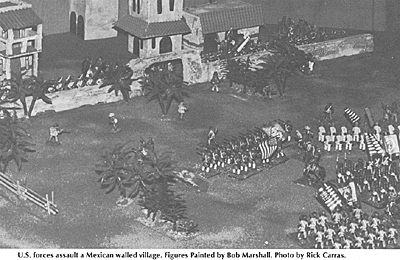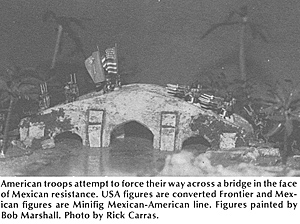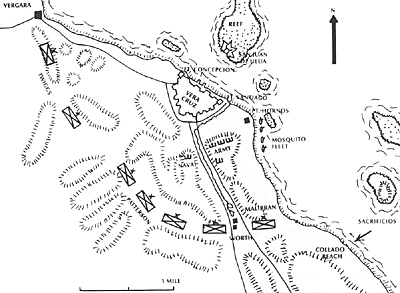 After General Zachary Taylor's conquest of Northern Mexico, a further advance to the South was considered impossible due to the logistical problems of the deserts. Since Mexico rebuffed the peace proposals, President Polk decided to capture Mexico's chief port of Vera Cruz and advance into the heartland.
After General Zachary Taylor's conquest of Northern Mexico, a further advance to the South was considered impossible due to the logistical problems of the deserts. Since Mexico rebuffed the peace proposals, President Polk decided to capture Mexico's chief port of Vera Cruz and advance into the heartland.
U.S. forces assault a Mexican walled village. Figures Painted by Bob Marshall. Photo by Rick Carras.
General Windfield Scott was assigned command of the expedition. General Taylor's army was to play a defensive role, so all the Regular Infantry (Worth's and Twiggs' Divisions) and half the Regular Dragoons, and Patterson's Volunteer Division were detached and marched to Tampico for embarkation onto transports. Commodore Conner gathered a fleet of 216 naval, transport and supply vessels at the rendezvous at Lobos Island. In addition Scott had requested the construction of 141 surf-boats specially designed foran amphibious landing. They were double ended, broad-beamed, and flat-bottomed, 35 to 40 feet long, and carried 40 troops plus eight sailors to man the oars.
On March 2nd the fleet set sail from Lobos, bound for Anton Lizardo, an anchorage 12 miles South of Vera Cruz. Rough seas sank a number of smaller vessels carrying horses and mules, but the larger transports weathered the storm. The vanguard of transports arrived March 4th and by the 6th most had reached the anchorage, except for 2,000 troops still enroute from the States. Scott made a personal reconnaissance in the steamer Pelrita, with all his command staff aboard. They checked outthe proposed landing site at Collado Beach and the defenses of the port. Vera Cruz was defended on the landward side by a 15 foot high wall of coral blocks, with a fort at both the North and the South ends of town, and 9 bastions along the wall.
The defenses contained 113 cannon and mortars. The seaward defense was Fort San Juan de Uloa 1,000 yards off shore, mounting 135 cannon and heavy mortars (see Table A for breakdown of the garrison). During this reconnaissance the Pelrita came under fire from the Fort. Although Scott was a careful general, he took a foolish chance, as one lucky hit could have wiped out all the leaders of the invasion.
Since the defenses ruled out a possible coup de main, the plans for a beach landing were implemented on March 9th. Worth's Division was the first wave to land, followed by Patterson's Volunteers and finally Twiggs' Regulars (see Table A). Two steamers and four schooner-gunboats provided fire support from 90 yards off shore. The only opposition was from a few Mexican lancers among the sand dunes, who scattered at the first cannon shot. Apparently, General Moralesdid not want to risk his small garrison outside the walls, but it seems that a well timed charge of lancers from out of the dunes could have wreaked havoc during the first moments of a landing. Probably the reason why they took no action was because there were only a few poor quality Coast Guard and irregular cavalry in the area. An interesting "what if" scenario could feature a couple thousand Mexican infantry and lancers facing Worth's landing.
The landing began at 5:30 p.m. and by 10:00 p.m. over 8,500 troops were ashore. But soon a storm blew in which lasted seven days, preventingthe landing of the siege guns. Meanwhile, the infantry gradually extended their lines around the city. There were many skirmishes with irregulars probing for a weak spot in the rear of the siege lines. On one occasion 55 General Morales made a reconnaisance in force with 1,000 men, but was forced back by Shields' troops. One group of a few hundred under Colonel Aquayo was successful in slipping into the city under cover of a stormy night.
Finally, the storm passed and the heavy artillery could be landed. Four batteries of mortars and 24 pounders were set up under the direction of Engineers Joseph Totten, Robert E. Lee,. and Pierre T. Beauregard. The batteries opened fire on March 22nd, butthey were not heavy enough to breach the walls, so Scott arranged with the Navy to land three 32 pounders and three 8" shell guns. It took 200 men to dragthe three ton guns the three miles to the battery site, 300 yards from the fortifications.
When the naval battery opened fire on the 24th, the heavy shells shattered the brittle walls, drove the gunners from their posts in the Santa Barbara bastion, detonated the magazine of Fort Santiago killing all the soldiers there, opened a 50 foot breach, and caused much destruction and loss of life in the city. The damage and casualties demoralized the garrison, which surrendered. Morales resigned rather than capitulate, so his second in command, General Landero, surrendered on March 29th.
During the siege the American artillery fired 6,700 shot and shell, with a total weight of 463,000 pounds, killing about 80 Mexican soldiers and 100 civilians, plus several hundred wounded (Bauer, p. 252). The Mexicans fired 8,486 shells and 6,267 shot, killing 19 and wounding 63 soldiers (American Star). The disparity in the casualties is explained bythe fact that although the Mexican fire was fairly accurate, the projectiles buried themselves in the sand revetments, while the stone fortifications broke into many potentially lethal fragments.
Most gamers look upon siege warfare as not very exciting, but with Scott facing a time limit (scattered cases of yellow fever began breaking out in the first week of April, and probably Santa Anna's army could have intervened by April 11th), the choices are sticky if the Mexican morale holds out. Do you prolong the siege and suffer increasing fever casualties? Or do you risk a bloody assault? The defender's morale could be handled by totalling points for casualties, guns knocked out (points = poundage of piece), and say 10 points for each 1 scale foot of breach. At the end of each siege day, percentile dice are rolled. If the dice total is less than the sum of the losses, the garrison surrenders.
SANTA ANNA RALLIES NEW DEFENSES
After their defeat at Buena Vista, Santa Anna's army straggled back to San Luis Potosi, were given four days rest and the besttroops were ordered to march to the defense of the Capital. This force consisted of the following (Miller, Alcaraz, pp. 147-150):
- Vasquez's Bde. - 1st, 2nd, 3rd, 4th Lt. Infy.
Ampudia's Bde. - 3rd, 4th, 5th, 11th line Infy. (4,000 Infy.)
Juvera's Cav. Bde. - 5th & 9th Line, Morelia Activo, Tulancingo Cuirassiers (1,500)
Artillery - "Flying Bty." & San Patricio Bty. (150 men)
Santa Anna had more than his knowledge of the impending invasion at Vera Cruz to worry about, on February 27th the "Polkos Revolt" broke out in Mexico City. The Polkos (polka dancers) were National Guard troops recruited from the middle class, who became dissatisfied with Santa Anna's Government, and occupied several public buildings. There were 3,250 rebels from the following battalions: Bravos, Indepenclencia, Victoria, Hidalgo, Allende Sappers, and the Mina Artillery Btn. (without cannon), plus 150 Line cavalry (Alcaraz, p. 157). The troops remaining loyal to the Government were the Guard Grenadier Btn. (1,000), Libertad Btn. (1,000), National Guard Artillery Btns. of Guerrero, Galeana, Verduzco & Matamoros (1,000 with 22 cannon), and 300 Line cavalry (Alcaraz, p. 158). The 6th Infy. Regt. of 700 men occupied a convent and remained neutral! The revolt turned out to be a rather bloodless one of proclamations and roof-top sniping, and in the end the Polkos capitulated upon Santa Anna's return.
While Santa Anna was reorganizing his government, he sent available units to Jalapa, forming the Army of the East under Major General Valentin Canalizo. After obraining a forced loan of two million pesos from the Church, in orderto finance the war, and appointing Pedro Maria Anayaas interim head of state, Santa Anna set out on April 2 to again take command of the army. The veterans of the Armyof the North werejoined by General Rangel's Bde.: Guard Grenadiers, 6th Line, Libertad Btn.,Galeana Naitonal Guard Artillery with 8 guns, plus two Sqns. of cavalry, which were probably the Guard Hussars (Alcaraz, p. 147). Santa Anna reached his hacienda at Encero on April 5. he chose to oppose the American advance at the pass of Cerro Gordo (Big Hill), where the National Highway passes between the 600 feet tall mountain called El Telegrafo (it had once been a link in a visual telegraph system) and the 500 feet deep gorge of the Rio del Plan. West of this point the highway runs through a narrow ravine flanked by rugged hills. Much of the terrain was covered with dense brush and small trees, especially to the North.
 American troops attempt to force their way across a bridge in the face of Mexican resistance. USA figures are converted Frontier and Mexican figures are Minifig Mexican-American line. Figures painted by Bob Marshall. Photo by Rick Carras.
American troops attempt to force their way across a bridge in the face of Mexican resistance. USA figures are converted Frontier and Mexican figures are Minifig Mexican-American line. Figures painted by Bob Marshall. Photo by Rick Carras.
Defenses
The defenses at Cerro Gordo were laid out by Engineer Lt. Col. Manuel Robles. Below is a list of the positions and troops.
- Right Wing:
General Jarero was in charge of the fortifications on the three pronged hill between the highway and the river.
- Right Fort: Gen. Pinzon with 7 guns (some say 5) incl. one 12# (500 men) Atlixco Btn. & 5th Line Infy. (detached from Ampudia)
Center Fort: Aranjo with 8 guns, Zacapoastla Btn. (300) Libertad Btn. (400) (from Rangel's Bde.)
Left Fort: Col. Badillo with 9 guns (or6) "various calibers" (250) Nati. Gd. Cos. of Coatepec, Jalapa & Teusitlan.
Reserve: 1 8#, (450) Matamoros Btn. & Tepeaca Btn.
Center: General La Vega was in command of the center defenses on the road. The West Point Atlas shows fortifications along the ridge leading to the three forts, but other maps do not.
Road Battery: 8 guns (or 7) incl. 4 16# (Galeana NtI. Gd. Arty.?) Rangel's Bde. (-) Gd. Grenadiers (900) & 6th Line Infy. (460). (Alcaraz gives the 6th 900 men and the Guards 460, but this seems to be in error, since earlier the 6th only had 700 men.)
Left Wing:
- El Telegrafo: General Vasquezwith 44# guns, (100) 3rd Line Infy. (it is not clear if there were only 100 men left, or if there may have been more of the 3rd in reserve.)
Reserve: 5 gun Bty. on knoll above village.
General Ampudia's Bde. (780) 4th & 11 th Line Infy.
General Vasquez's Bde. (1700) 1 st, 2nd, 3rd, & 4th Lt. Infy.
General Canalizo's Cavalry (2,000)
- Gd. Hussars
Juvera's Bde.: 5th & 9th Cav., Morelia Activo Cav., Tulancingo Cuirassiers
Unbrigaded: Militia Sdns. of Jalapa, Chalchicomula & Orizava.
Lt. Cav. of Mexico? Oaxaca Activo Cav.? These two are not listed in Alcaraz, but are listed by Hefter as present.
Total Army = 7,840 plus 5000) gunners (Alcaraz, pp. 201-202 & Hefter, p. 79).
Note: The San Patricio Bty. was present, but its location is unknown. It would not have been under Jarero, as all these troops were captured. It probably was with La Vega's command. Since this position was not directly attacked, nothing specific was recorded about them.
Despite the strength of the position, Col. Robles feared that their line of retreat could be cut by a turning movement on the left. Santa Anna brushed aside this contrary opinion with a scathing remark: "Cowards never felt safe anyway." (Nevin, p. 142). Such brash overconfidence gave his officers feelings of impending disaster. Also, many of the officers and men were infected with the notion of Yankee invincibility. Many of the veterans were worn out and sickly from their long marches. Many of the soldiers were new recruits and militia, who lacked training. Looking at the army in retrospect, it seems to have been psychologically ready for a rout.
 VERA CRUZ, MARCH 9-29,1847 Source; Vincent Espisito, ed., The West Point Atlas of American Wars (New York: Frederick A. Prager, 1959), Map 15b; Jack Bauer, The Mexican War, 1846-1848 (New York: Macmillan, 1974), p. 243.
VERA CRUZ, MARCH 9-29,1847 Source; Vincent Espisito, ed., The West Point Atlas of American Wars (New York: Frederick A. Prager, 1959), Map 15b; Jack Bauer, The Mexican War, 1846-1848 (New York: Macmillan, 1974), p. 243.
GENERAL SCOTT ADVANCES
After the fall of Vera Cruz, General Scott had to spend much time rounding up sufficient draft animals. Scott's immediate goal was Jalapa, 74 miles along the National Highway to Mexico City. Jalapa's 4,000 foot altitude would be more healthy. The American advance began on April 8th, with General Twiggs' Division of Regulars, followed the next day by General Patterson's Volunteers. Scott stayed behind with Worth's Division in order to arrange sufficient transportation for their baggage train.
On April 11th Twiggs crossed the Plan del Rio. The next morning's reconnaissance by the Dragoons discovered the Mexican position at Cerro Gordo. After further scouting, Engineer Lt. Beauregard concluded that the defenses were manned by about 4,000 men and could be turned by occupying the hill of Atalaya. He was not aware of the El Telegrafo positions. General Twiggs was not interested in Beauregard's outflanking idea. According to historian Jack Bauer, "'Old Davy' Twiggs, a physically impressive figure with powerful shoulders and a bull-neck... was not one of the army's intellectuals and held to a simple tactical concept -- attack." (Bauer, p. 263).
Despite the reports of the enemy force in front, Twiggs impetuously marched his column right up the highway! The Mexican fire drove back his advance guard, and he was persuaded that more scouting was needed. He ordered a frontal attack at 4:00 the next morning, but Generals Pillow and Shields requested a twenty-four hour postponement because their troops had just arrived after an exhausting march. Finally, General Patterson arose from his sickbed, asserted his seniority to command, and cancelled the apparently suicidal attack.
Meanwhile, on the 11th, Scott had received Twiggs' report of impending action, and he left immediately to join the army. Quitman, Worth, and the siege train were ordered to move up as quickly as possible. Scott arrived on the afternoon of the 14th and ordered a careful three-day reconnaissance. Chief Engineer, Captain R.E. Lee scouted through the brush and discovered a path that led around the Mexican left flank. During one of these explorations, he became separated from his escort and had to hide for hours behind a log to avoid capture by Mexican pickets. It seems that this incident could be an interesting scenario for a skirmish game.
While Lee was scouting, the Sapper Co. worked on clearing the trail and erecting brush screens to conceal troop movement. Santa Anna refused to believe his pickets' reports of chopping sounds in the brush.
Based upon the thorough reconnaissance reports, Scott planned a two-pronged attack for April 18th. Pillow's Brigade was to make a diversionary attack in front, while Twiggs' Regulars and Shield's Volunteers were to move along Lee's trail and cut off the Mexican line of retreat. When Worth's Division arrived, they were to be the reserve, acting in support of Pillow or conducting the pursuit. There was little change in the organization of Scott's army. The strength of the Divisions were:
- Worth's Division, 2,416;
Twiggs' Division, 2,412;
Patterson's Division, 3,367,
for a total of 8,295 (Nevin, p. 144).
Regular Regts. averaged 400 men and Volunteers 500.
The cavalry numbered perhaps 700 Dragoons and Tennessee Mounted Rifles.
Vera Cruz and Cerro Gordo Campaign 1847
Back to Table of Contents -- Courier #55
To Courier List of Issues
To MagWeb Master Magazine List
© Copyright 1991 by The Courier Publishing Company.
This article appears in MagWeb (Magazine Web) on the Internet World Wide Web.
Other articles from military history and related magazines are available at http://www.magweb.com